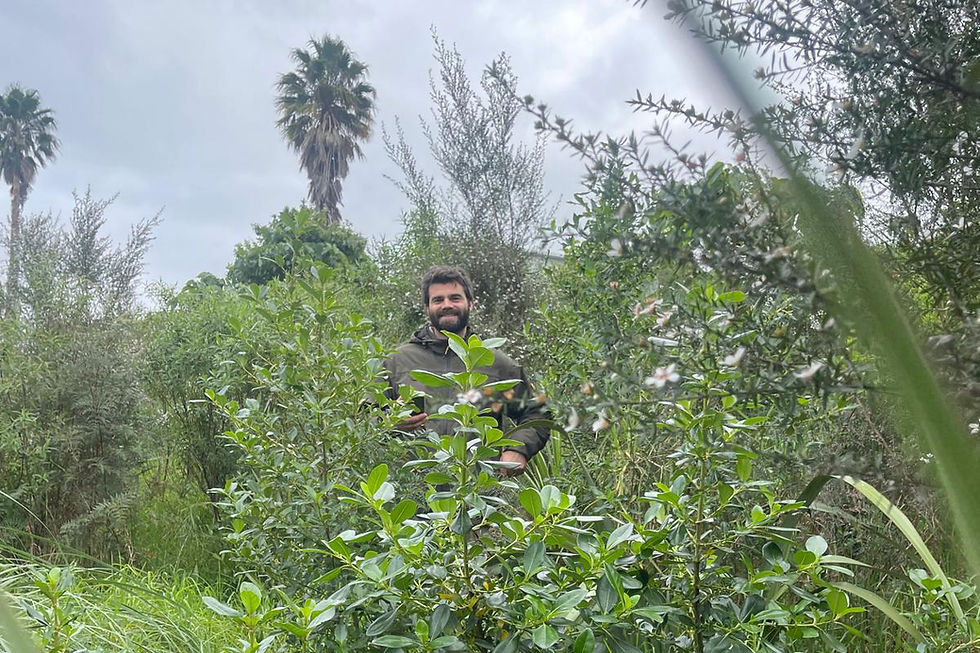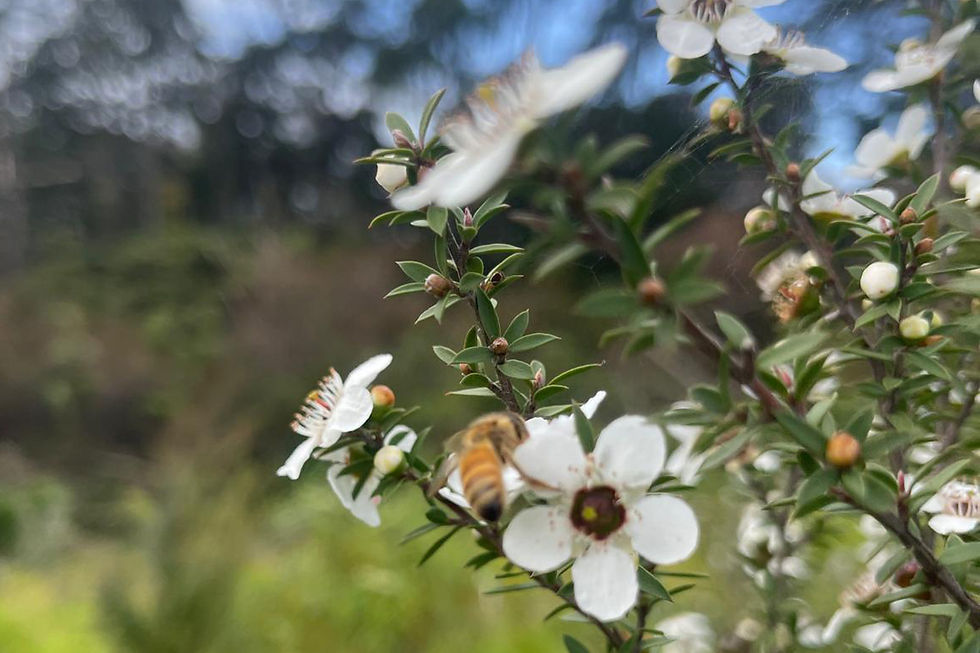Canopy cover marks pivotal step in restoration
- Te Hōnonga a Iwi

- 13 minutes ago
- 5 min read

Student journalist Alex Zhang takes a deep dive into the significance of achieving 50 per cent canopy cover ahead of expectations at the original planting section of our native bush restoration.
The 2022 planting site at Te Hōnonga a Iwi’s native forest restoration in Rosedale Park has achieved 50 per cent canopy cover, two years ahead of schedule. It’s a monumental achievement and will accelerate positive changes, including creating safe spaces for flora and fauna that thrive in shelter and indirect light and controlling the growth of weeds and invasive species.
What is canopy cover?
Canopy cover measures the proportion of land that is covered by the vertical projection of a tree’s crown, while total urban canopy cover (TCC) describes the amount and horizontal distribution of urban ngahere (forest) canopy within a given city.
Canopy cover in urban areas is especially important because higher canopy cover in cities is linked to better climate change mitigation, reduced air pollution, and improved water quality. In New Zealand, cities often aim for a TCC target between 20 per cent and 30 per cent forest biome. However, this does not preclude cities from aspiring to greater canopy cover! Upper Harbour Local Board boasts an incredible 28 per cent canopy cover, 13 per cent above the desired level within the 2021 Urban Ngahere Strategy, a set of regional plans adopted by the Auckland Council to increase the city’s tree canopy by 2050.
Unfortunately, according to Nicky Shave, the Project Co-ordinator at Te Hōnonga a Iwi, Albany has one of the lowest canopy covers in our rohe (district) and the lack of vegetation cover is reflected by poor freshwater quality results.
Te Hōnonga a Iwi is now working with iwi, other local restoration groups, Auckland Council and the Upper Waitemāta Ecology Network to reverse these statistics, and, as Nicky says herself, “We are aiming to shift the one-star bird hostel within Rosedale Park to a five-star living space that will allow safer, happier passage of birds and native wildlife transiting through the North-West Wildlink from Tiri Tiri Matangi to Waitakere Ranges.”
Ultimately, the restorations team is hoping for Rosedale Park will become a life house for all wildlife to reside within and become the first restoration to be climate positive (carbon negative), offering a healthy space that invests positively in future generations of humans, flora and fauna.

Why is canopy cover so important?
Canopy cover is important because it signifies the transition from scrub cover (essentially a single layer of vegetation) to an ecosystem with an established canopy and a distinct understorey. This results in the opening up of more spaces for flora and fauna that thrive in shelter and indirect light, increasing the ecological value of the restoration.
Another reason why canopy cover is desirable is it can effectively control the growth of weeds and invasive species. In fact, the majority of threatening weeds that are likely to damage young natives are reliant on direct sunlight, with only some species, such as tradescantia and ginger, able to grow in the shade.
What has contributed to this achievement?
Matt Cummings from Untangled Landscapes, the restoration’s regenerative landscaping expert, believes using regenerative methods to improve the soil biome at Rosedale Park is the biggest contributor to the accelerated canopy cover.
Matt and his team started by taking a look at the existing relationship between microbiomes and their corresponding photosynthetic energy supplies (basically plants) and found that initial reports included just a few pieces of fungi in the samples and no protozoans. This means that the soil is poor in nutrients, which prevents the canopy floor from diversifying.
After getting these results, Matt was able to deduce, based on the land’s history, that a large amount of fill had been brought in and pushed down upon the native vegetation that had once inhabited the valley. This would explain why there was a thick layer of inert subsoil on much of the hillside. This layout of the soil meant that there was little organic matter (OM per cent) in the subsoil, preventing the forest floor from advancing in complexity until aspects such as bacterial growth is controlled.
In order to rejuvenate the area, Matt and other volunteers successfully cleared the canopy and exposed the soil. They were able to save and compost the aboveground biomass, so that some precious soil building work that had been achieved in the last few decades could be retained.
Matt then amended the microbiome with a carefully farmed diverse living compost made by Untangled Landscapes, which mimics the biological composition of the organic litter that would have built up on the soil over the next few decades, and made sure it had a healthy population of protozoa.
In addition to providing microbiomes, the compost also provides an injection of OM which is important for historically low OM soils. His team also included a nurse plant seed blend in the compost in order to diversify the site species portfolio. This also prevents the forest floor from being dominated by weed species, which are now seven times less competitive in regenerative areas as opposed to before.
Matt’s efforts are now paying off as the regenerative section of the site boasts a 20 per cent increase in survival rate and more than twice the growth rate compared to control areas, where similar species of natives were planted with the same bioorganic compost, planting density and height.

The only differences were that the land was not cleared using regenerative techniques, and cover crops were not used when planting natives. This result is crucial in proving that regenerative agriculture and sustainability principles can produce better outcomes than traditional restoration techniques that use herbicides, pesticides, commercial fertilisers and a much higher carbon footprint to produce results.
With canopy cover helping supress invasive plant species, Matt is now looking forward to seeing the new forest floor transition from weed and grasses to ferns, shrubs and juvenile natives over the coming years. This will, in turn, support a further shift in the soil microbiome, enriching the forest floor.
How can Te Hōnonga a Iwi help maintain canopy growth?
“To maintain and increase canopy growth even more, we hope that businesses in the district will grow green walls and that the Alexander Stream corridor, where we work at the moment, will continue to sustainably develop its canopy across the next 100 years, enhancing the ngahere and connecting the bush to significant natural spaces like Fernhill Escarpment, Burnside Reserve and Lucas Creek in ways that would sequester more carbon than humans produce.” says Project Co-ordinator Nicky Shave.
Furthermore, Nicky says the project teams plans to set a SMART tree canopy target to reach for and will continue to monitor changes in the canopy with support from AUT Environmental Science students.
What does this achievement mean for the restoration and the wider community?
According to Nicky, the Upper Harbour area has lost two per cent canopy cover on residential land but gained cover on roads and public land. Local residents and the business development precinct could make a colossal difference to increase canopy cover in Albany by planting natives, fruit trees and non-invasive exotic trees. The benefits of canopy cover are monumental and accumulative, especially in the climate crisis era.
Achieving increased canopy cover has so many benefits for nature, local communities and businesses. In the climate crisis, it can reverse biodiversity loss, create pollinator paths, offer shelter and food for birds, insects, frogs and other bioaquatic species.
It will mean the area will be refreshing to spend time in, allowing people to improve their wellbeing while reducing the urban heat island effect and offering shade. Urban ngahere are the lungs of a city, reducing hospitalisations, flooding impacts and heat related illness such as cardiac and respiratory disease.
Urban forests can also sequester carbon, mitigate climate change impacts, increase food security, water quality, property values and, as a side effect, reduce healthcare and insurance costs. In short, investing in growing nature supports our cultural heritage and promotes mauri ora, health and wellbeing, of people, business, and our place.





Comments